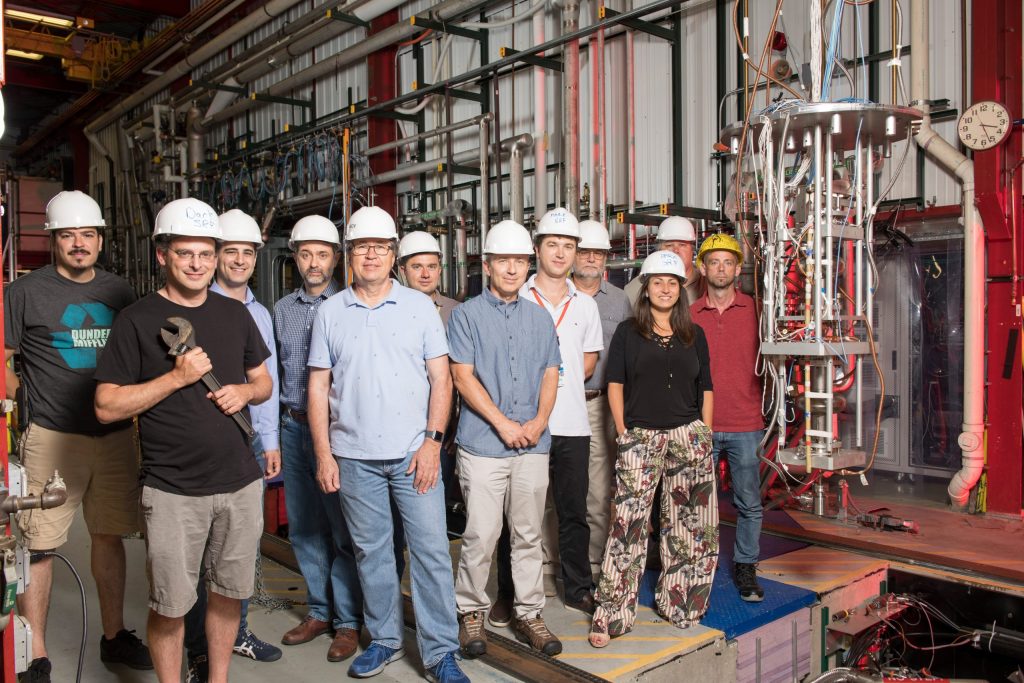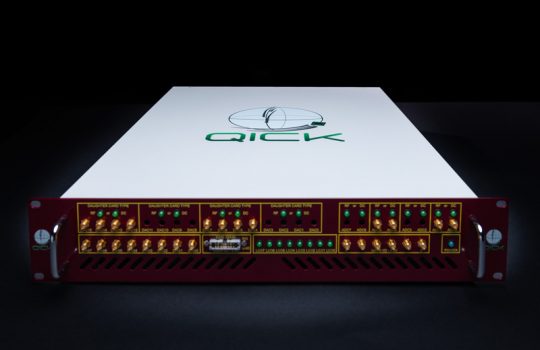Photons are the fundamental particles of light. They illuminate our world, letting us see the universe we live in. But light has failed to show us an extraordinary 85% of the matter in the universe, called dark matter. Scientists hope that an as yet unseen cousin of the photon, called a dark photon, will provide a clue about the nature of this mysterious dark matter.
A dark photon may sound like a contradiction in terms, but physicists use it to describe the hypothesized, photon-like particles that simply pass through ordinary matter. These invisible particles are part of the hypothetical dark sector — less ominously known as the hidden sector — of quantum fields and particles.
Scientists Anna Grassellino, Roni Harnik and Alexander Romanenko lead the Dark SRF experiment at the U.S. Department of Energy’s Fermilab. To search for the elusive particles, the team has repurposed technology developed for particle accelerators. The researchers hope to generate dark photons and then spot signs of them traveling through solid metal.
The theorized dark photon has the same properties as a photon, but a different mass — that is, if it has any mass. (Photons are massless.) Also, dark photons and photons are inextricably linked: One type can morph into the other, and dark photons interact with matter only through this transforming act.
Fundamental particles are already known to come in varied copies of each other. For example, the familiar electron has two similar, heavier cousins — the muon and tau. That pattern is an important motivation in looking for dark photons, explained Harnik, the main theorist on the project.
“The fact that the muon exists as a copy of the electron makes one wonder whether nature tends to have several copied of each particle. If so, perhaps there is a similar replication of the photon,” Harnik said. “That’s the dark photon.”
Although theorists can propose the dark photon, theory alone cannot predict its mass or its interaction probability. Experimenters and observers have been able to eliminate broad swaths of possible properties. But the search in unexplored territory is on.
Grassellino, who is the Fermilab deputy chief technology officer and led the organization of the experiment, explained that theorists are pushing experimentalists “in all possible directions to fill this map and say, ‘Oh, nothing here, nothing here, nothing here. Where else should we look?’”

During experimental runs of Dark SRF, two cavities (shown here) are bathed in liquid helium to keep them cold. One is held perfectly still, tuned to a specific frequency and kept as empty of photons as possible. The other cavity, which is intended to generate dark photons, has a special setup to adjust it to match the frequency of the first cavity in real time. The experiment aims to catch photons produced in the adjustable cavity as they make their ghostly journey, through metal walls, into the empty cavity. Photo: Reidar Hahn, Fermilab
A technological case of adaptive reuse
The Dark SRF experiment searches for dark photons in a region that researchers have yet to probe. The region might be said to be low-hanging fruit for Fermilab, but it would be more accurate to say that Fermilab had already designed and built a tall enough ladder to easily harvest new dark photon fruit.
This metaphorical ladder is the superconducting accelerator cavity. Cavities are hollow, metal, resonating structures in particle accelerators that push particles to near the speed of light. Over the last decade or so, Fermilab has made sweeping strides in increasing their efficiency, getting particles to higher energies over shorter distances.
Romanenko was the first to realize that Fermilab’s cavities are seemingly tailor-made for a different use and could be instrumental in the search for dark photons.
“At Fermilab, we have unique technologies that we’re pushing to unprecedented levels of sensitivity or efficiency,” Grassellino said. “We recognize that we need to also make the effort to either think of what we can do with it for unique experiments like Dark SRF or make them available to the other experimenters.”
In Dark SRF, the superconducting cavity is designed so that photons of a specific microwave energy oscillate together, bouncing back and forth inside it about a 100 billion times before being lost. The cavity maintains the microwaves in much the way a bell or tuning fork maintains sound vibrations.
When kept filled, a cavity can contain around 10 septillion photons — a 1 followed by 25 zeroes. That’s about the number grains of sand in all the deserts and beaches in one thousand Earths (based on a high estimate of how sandy Earth is). The cavity’s astronomically high photon capacity makes it perfect for coaxing hypothetical dark photons out of their hiding place: Each of those regular photons has some chance of being converted into its dark counterpart — an alluring bet that dark photons will be seen, if they exist.
“If a dark photon indeed exists, the filled superconducting cavity acts as a transmitting antenna of dark photons,” Harnik said.
In addition to their excellence in storing photons, the cavities can also keep out stray light, creating a perfect place to hunt for photons arriving unexpectedly. In Dark SRF, a second empty cavity would pick up a dark-photon signal that originated from the 10 septillion photons vibrating inside the first.
“The beauty of this experiment is it’s so simple, given that we have all this technology in hand,” Romanenko said. “We’re starting to push these cavities into the quantum regime, pairing a cavity bursting with photons with another almost completely devoid of them and being able to detect a single one.”
A dark photon’s journey
If dark photons exist, it is their ability to travel through walls that the Dark SRF team will use to identify them. The Dark SRF experiment brings significantly improved technology to a type of undertaking called a “light shining through a wall” experiment, which looks for light making a seemingly impossible journey through an opaque barrier.
The experiment uses two cavities, one above the other, that are bathed in liquid helium to keep them cold. One is held perfectly still, tuned to a specific frequency and kept as empty of photons as possible. The other cavity, which is intended to generate dark photons, has a special setup to adjust it to match the frequency of the other cavity in real time.
The experiment aims to catch photons produced in the adjustable cavity as they make their ghostly journey, through metal walls, into the empty cavity.
The journey begins when some of the 10 septillion photons that are bouncing around the tunable cavity convert into dark photons, which then pass through the wall of that cavity. Dark photons’ lack of interaction with mundane matter makes them invisible to us. It also renders the walls of the cavities, and everything else, intangible to them. Some of these dark photons will travel into the other cavity, and some fraction of those will revert into regular photons.
The appearance of these seemingly teleported photons signals the existence of their dark cousins. Sighting them would be the eureka moment.

The Dark SRF team at Fermilab is advancing the search for dark photons. Photo: Reidar Hahn, Fermilab
The Dark SRF difference
The success of Dark SRF’s simple design hinges on the extraordinarily fine calibration of the two chambers. The second chamber acts as a trap, capturing the reverted photons. But it will build up a noticeable number only if the two chambers’ frequencies precisely match. Otherwise, the photons’ journeys end with them being quickly absorbed by the second chamber’s walls, never to be seen, and the dark photon will continue to fly under the radar.
How fine must the calibration be? The required alignment is unforgiving: The roughly quarter-meter-long cavities must be perfectly positioned to within a billionth of a meter. That’s like correctly plotting the length of a regulation soccer field to within the length of a chromosome.
And once in harmony, these chambers become magnificently sensitive antennas. This is thanks to their high quality factor, a measure of how efficiently they retain energy. The higher the quality factor, the more photons the generating cavity produces, and the more sensitive to dark photons the receiving cavity becomes. The Dark SRF cavities have a quality factor of 1011 when chilled to 1.4 kelvins — the highest-efficiency engineered resonators in the world. Their quality factor leads to both a flood of potential progenitor photons and heightened sensitivity — both of which give scientists a fighting chance of plucking a dark photon from the vacuum.
Fermilab’s expertise in cryogenic cooling also contributes to Dark SRF’s ability to explore new ground in the search for dark photons. Any photons converted from dark photons must be picked out from a background crowd of other, normal photons generated by the cavity’s heat. In Dark SRF, the cavities’ cold 1.4-kelvin temperature helps reduce the background to a mere 1,000 in the receiving cavity. Researchers plan to modify the system in the future to operate at about 6 millikelvins, winnowing the number to less than one on average and providing the opportunity to search for a more elusive version of the dark photon.
“If you want to hunt for one photon, we are the only place in the world where you can do that with a cavity,” Grassellino said.
Blue sky science for the dark world
The Dark SRF experiment is an example of how technology and expertise developed for a particular purpose — designing efficient particle accelerators — finds use in another pursuit — searching for hidden particles.
Since it began operation in 2019, scientists on the Dark SRF Experiment have already made significant progress in their search. They’ve experimentally ruled out values for a particular quantity, called a kinetic mixing, that would point to the existence of a dark photon of a certain mass range (between 10 billionths and hundreds of millionths of an electronvolt). This narrows the possible values of the kinetic mixing by a factor of 1,000 compared to previous searches. Now they are pushing at the boundary of the parameter measurement by repeating the experiment using advanced quantum techniques.
If the experiment does find evidence of dark photons, it will introduce a whole world of new questions to be explored: How common are dark photons in the universe? Are dark photons the dark matter scientists have been eagerly searching for? Do dark photons interact with other dark matter similar to how photons do with regular matter? If so, do they reveal another part of our universe as complex as our own but previously invisible?
Whether the Dark SRF experiment discovers the dark photon or not, it will contribute to our understanding of the dark matter that we know is there but have yet to see.
“The path forward follows what we all learnt at school: In science we make a hypothesis, we test it.” Harnik said. “If we find it, ‘Hooray!’ If we don’t find it — science progressed.”
This work is supported by the DOE Office of Science.
Fermilab is supported by the Office of Science of the U.S. Department of Energy. The Office of Science is the single largest supporter of basic research in the physical sciences in the United States and is working to address some of the most pressing challenges of our time. For more information, visit science.energy.gov.



